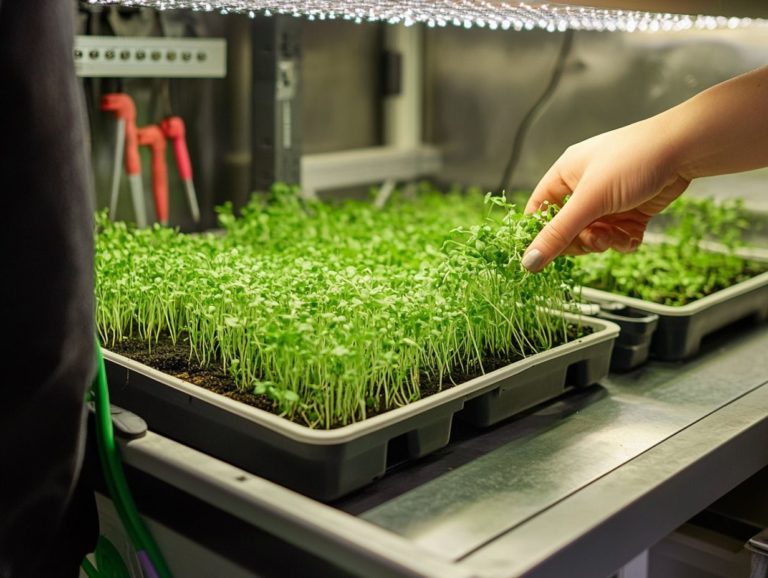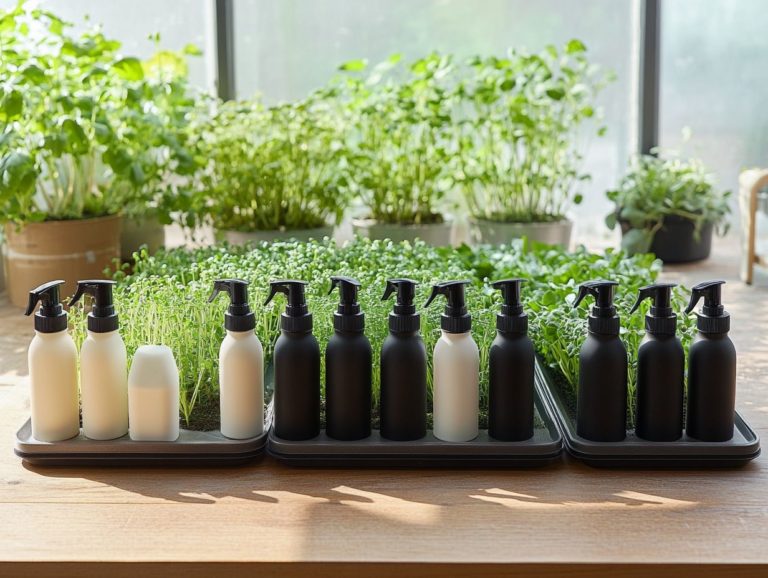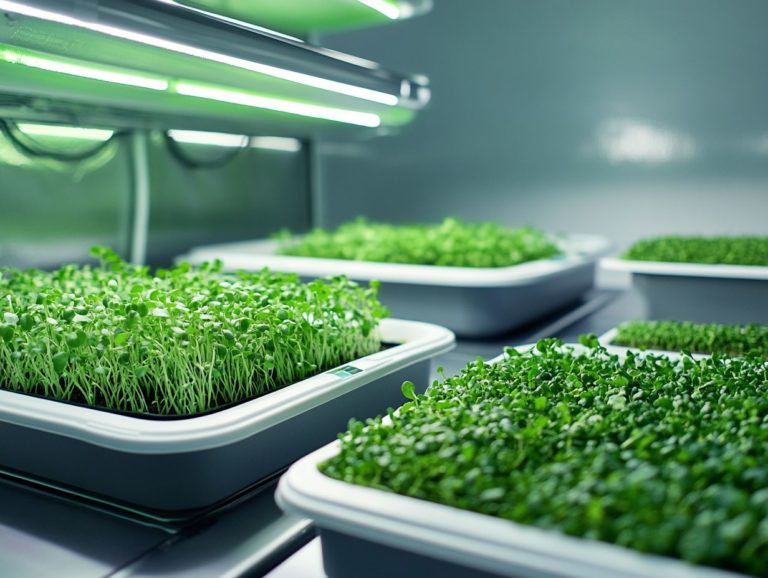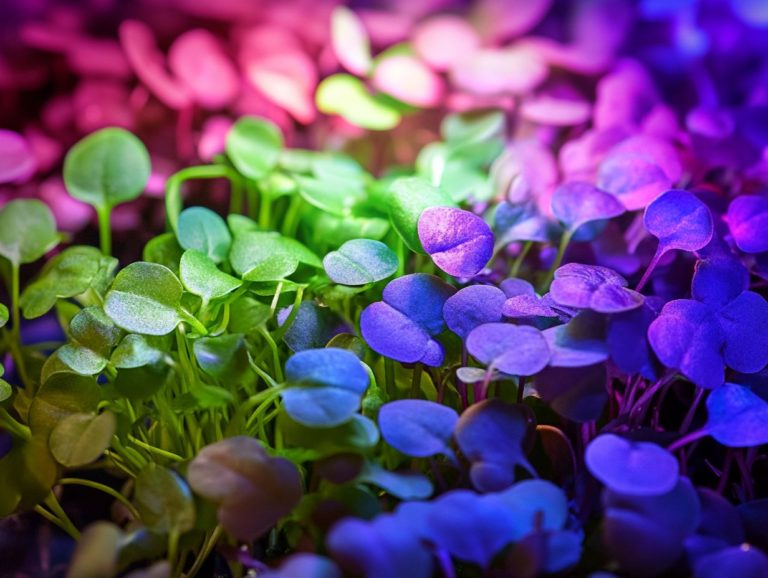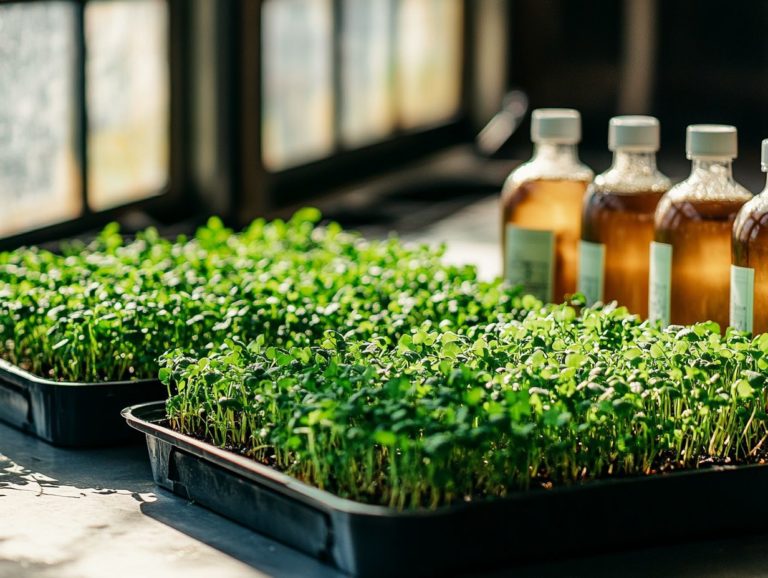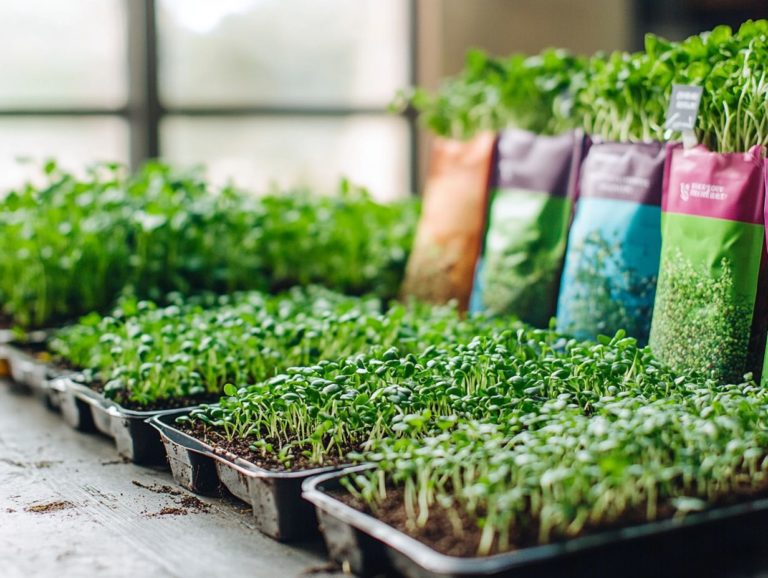How to Properly Store Microgreen Supplies
Microgreens have taken the culinary scene by storm, delivering vibrant flavors and incredible nutrition in small packages.
Whether you re an experienced gardener or a beginner, starting your microgreen journey is simple. It begins with having the right supplies.
This article will show you the essential tools you need for growing microgreens. You’ll also learn how to store seeds and soil effectively.
Explore the content to unlock the secrets of maximizing your microgreen growing experience!
Contents
- Key Takeaways:
- Essential Supplies for Growing Microgreens
- Proper Storage of Microgreen Supplies
- Maximizing Shelf Life of Microgreen Supplies
- Organizing Your Microgreen Supplies
- Frequently Asked Questions
- What supplies do I need to properly store microgreens?
- How should I clean and prepare my storage containers?
- Can I reuse containers to store microgreens?
- How should I store microgreen seeds?
- How often should I check on my stored microgreen supplies?
- How long can I store microgreen supplies in the refrigerator?
Key Takeaways:
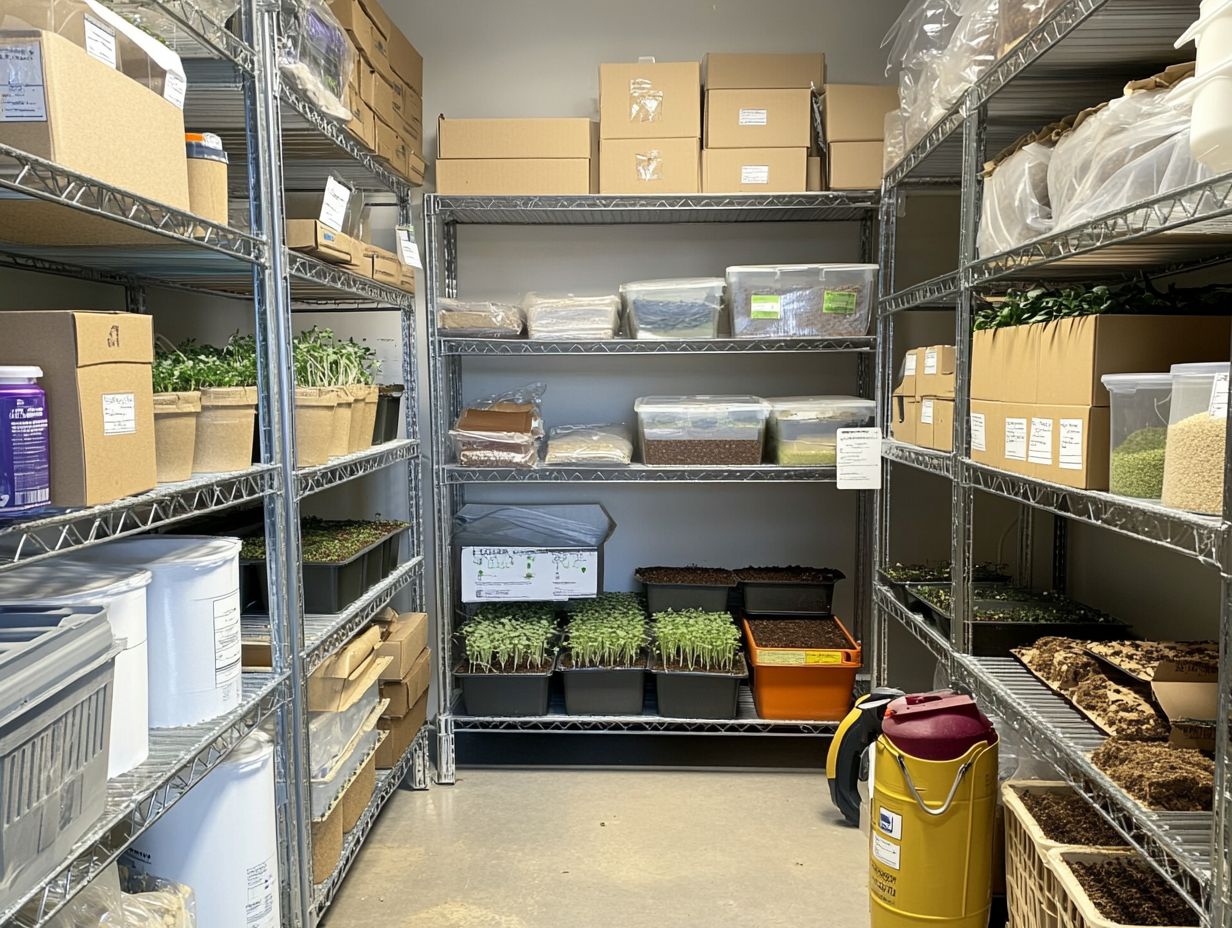
- Properly storing microgreen supplies is essential for keeping seeds viable.
- Store seeds in a cool, dry place and use airtight containers to maintain quality.
- Keep soil and containers clean and organized to extend their lifespan.
What are Microgreens and Why are They Popular?
Microgreens are young seedlings of edible vegetables and herbs. They are popular for their bold flavors and impressive health benefits.
Varieties like broccoli, kale, arugula, and radishes are rich in antioxidants. These tiny greens enhance flavors in many dishes while appealing to health-conscious consumers.
Microgreens have roots in ancient farming practices but are now trending in urban farming and health circles. They are easy to grow and deliver a concentrated punch of vitamins C, E, and K.
You can experiment with flavors like the peppery bite of mustard greens or the sweetness of pea shoots. As sustainable eating gains momentum, the demand for microgreens keeps rising.
Essential Supplies for Growing Microgreens
To grow microgreens at home, you need a few key supplies: high-quality seeds, soil with plenty of nutrients, and suitable containers for growth.
Each component is vital for creating the best conditions for seeds to sprout. You’ll end up with vibrant microgreens packed with nutritional benefits.
Whether you choose popular options like peas and sunflowers or try unique varieties like amaranth and cabbage, having the right supplies will enhance your gardening experience.
Seeds, Soil, Containers, and Other Must-Haves
Selecting the right seeds, soil, and containers is essential for your microgreen cultivation success, as these elements directly impact growth rates and overall health.
Popular choices for microgreen seeds include broccoli, kale, and arugula, all of which flourish in well-draining soil.
Containers like Lock & Lock, readily available on platforms like Amazon, provide the ideal environment for germination and growth. By investing in high-quality supplies, you ensure that your microgreens not only grow robustly but also deliver maximum nutritional value and freshness.
For the best results, it’s wise to source seeds from reputable vendors to guarantee high germination rates.
Soil enriched with organic matter enhances nutrient retention and fosters healthier root development, while lightweight trays promote drainage and airflow.
Opting for covered containers can help maintain moisture levels during the germination phase, significantly boosting your chances of success.
To simplify the process even further, consider complete kits that bundle all the necessary components, making your initial setup both straightforward and enjoyable. Get excited about harvesting bountiful, delicious microgreens!
Proper Storage of Microgreen Supplies
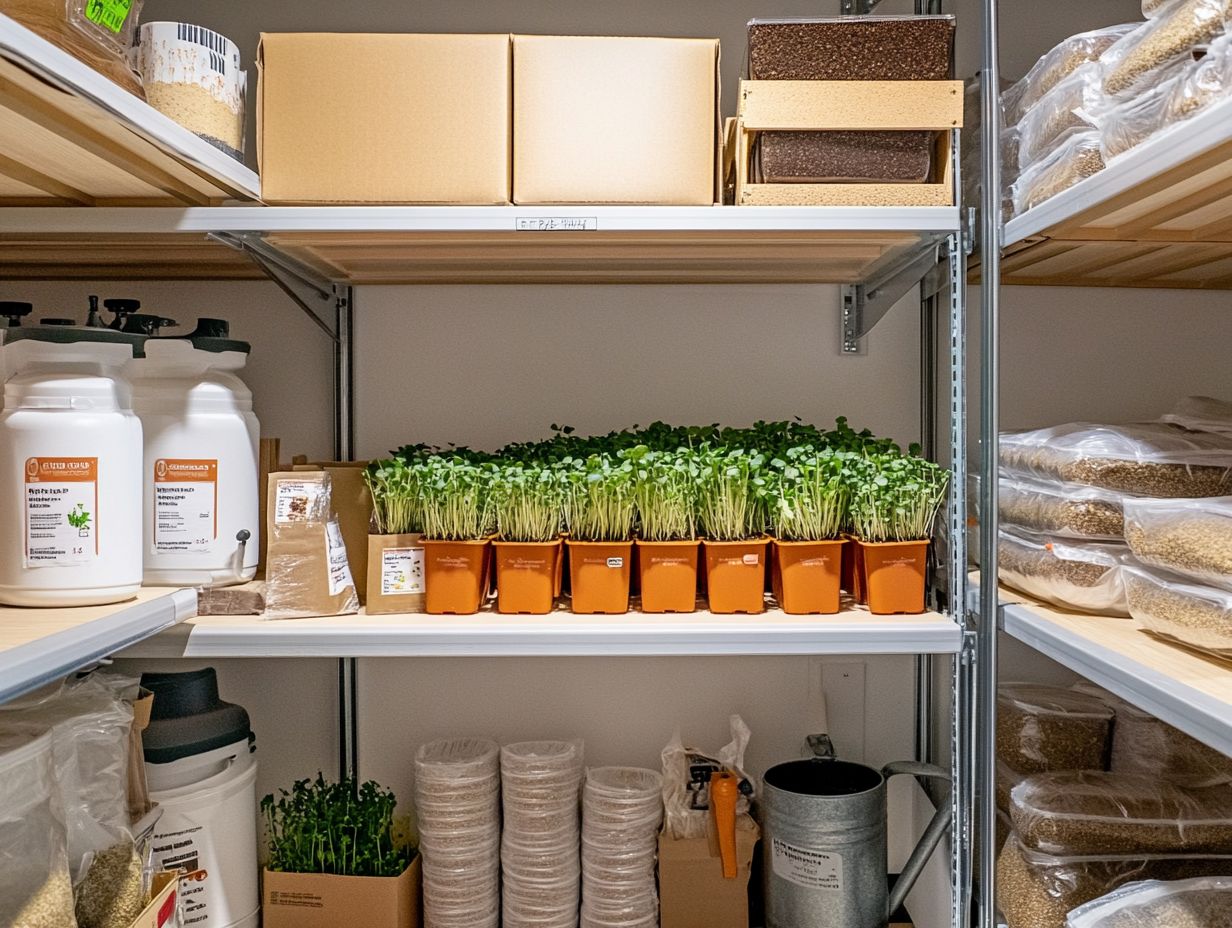
Proper storage of your microgreen supplies is crucial for preserving their ability to grow and ensuring the nutrients within them stay intact, allowing for the optimal growing experience.
Regarding storing seeds and soil, pay close attention to moisture levels to avoid spoilage and degradation of quality.
Utilizing airtight containers is an excellent strategy to prevent condensation, which can lead to mold and loss of seed viability. By doing so, you safeguard the health benefits these tiny greens offer.
Tips for Preserving Seed Viability
To ensure the viability of your microgreen seeds, managing internal moisture levels effectively is essential. Excessive moisture can lead to seed rot or mold growth, both of which diminish the health benefits you seek.
Store your seeds in a cool, dark place and use moisture-absorbing packets to maintain optimal moisture levels while preventing condensation. These careful measures will guarantee that when you’re ready to grow, your seeds will germinate efficiently, delivering fresh microgreens brimming with nutrients. For those new to gardening, consider checking out this guide on how to start a microgreen garden for beginners.
Using airtight containers for storage can further shield your seeds from environmental fluctuations. Keeping an eye on moisture is equally crucial; a humidity indicator can serve as a valuable ally.
If you reside in a particularly humid area, incorporating silica gel packets will absorb excess moisture, ensuring your seeds’ longevity.
Allowing your seeds to acclimatize to room temperature before planting can significantly enhance germination rates. These meticulous strategies not only foster seed resilience but also contribute to the nutritional density of your microgreens, transforming them into a powerhouse of vitamins and minerals for your health.
Best Practices for Storing Soil and Containers
Implementing best practices for storing soil and containers is essential for ensuring your microgreens thrive as you embark on your gardening journey.
Keep the soil in a dry, cool environment, shielding it from external moisture that could lead to degradation and nutrient loss.
Ensure that the containers used for growing microgreens are cleaned and stored properly to maintain hygiene and readiness for their next use.
To achieve optimal storage conditions, consider using airtight containers that protect the soil from humidity and pests. A dedicated storage space, away from direct sunlight and temperature fluctuations, will further preserve the soil’s integrity.
For those containers, thorough cleaning after each use minimizes the risk of disease and cross-contamination. Elevating materials off the ground on shelves or pallets can help prevent moisture absorption from the floor.
By following these practical tips, you can maximize both soil quality and microgreen growth, resulting in healthier plants and a more fruitful harvest.
Maximizing Shelf Life of Microgreen Supplies
Maximizing the shelf life of your microgreen supplies requires a keen understanding of effective storage techniques and the factors that influence their longevity. By using appropriate packaging and maintaining optimal storage conditions, you can keep them fresh longer.
This is essential for preserving their nutritional value. Armed with this knowledge, you have the power to fully enjoy your microgreens, whether you re cultivating them for personal use or employing them in culinary creations.
How to Extend the Life of Your Supplies
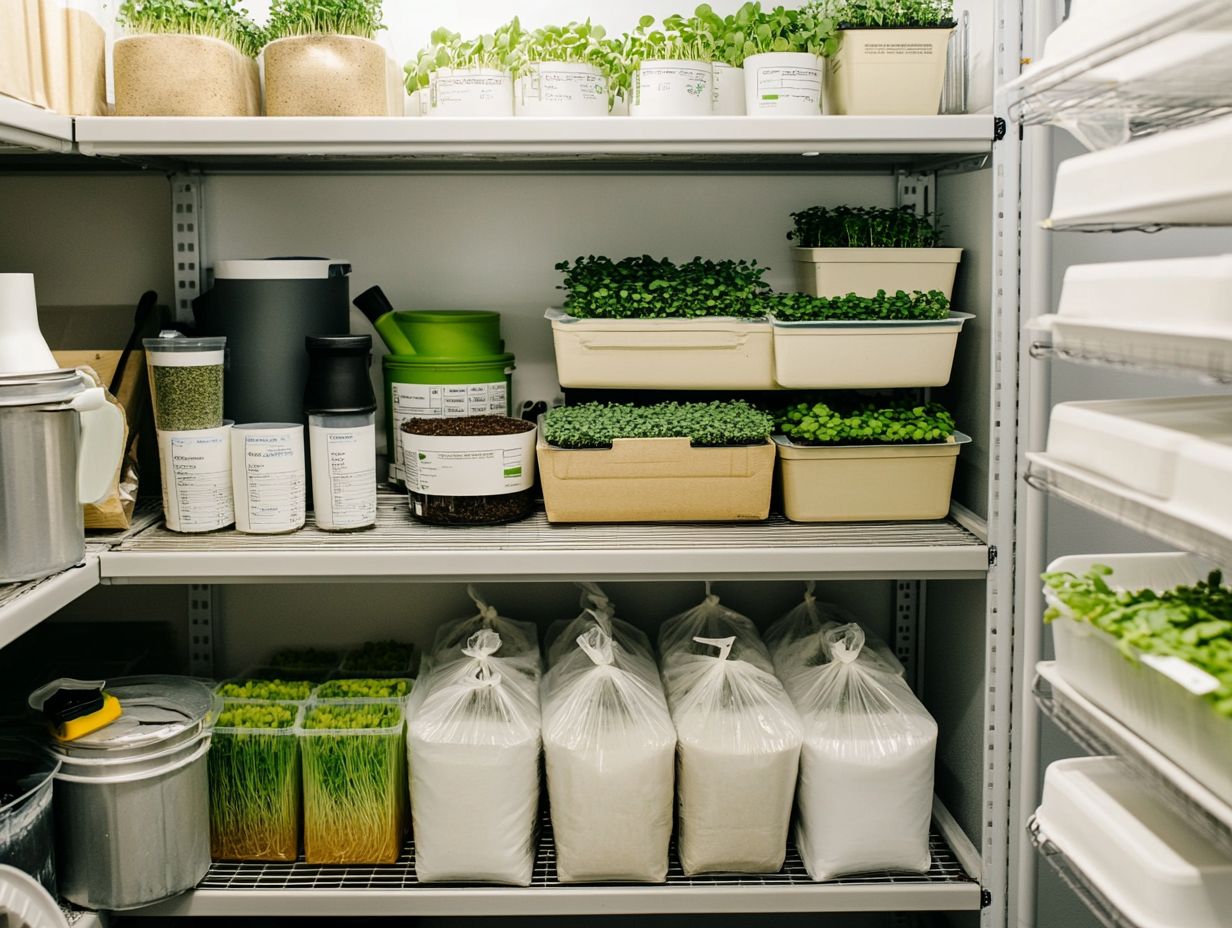
To extend the life of your microgreen supplies, it s essential to grasp the delicate balance between internal and external moisture. Ensuring the conditions are just right will help preserve their freshness.
The best way to maintain quality is to store them in a cool, dry space, using airtight containers that prevent moisture buildup while allowing for air circulation. This smart move keeps your microgreens fresh and ready to grow whenever you are!
Keep an eye on humidity levels, as they can significantly impact freshness. Using humidity packs or desiccants helps create the ideal environment, warding off excess dampness that might invite mold growth.
Using dark, opaque containers helps protect your microgreens from light exposure, which can degrade their quality over time. To maximize growth, consider learning how to use grow lights for microgreens. These strategies work together to keep your microgreens fresh and flavorful, ensuring you enjoy their vibrant tastes and superior nutrition for as long as possible.
Organizing Your Microgreen Supplies
Organizing your microgreen supplies with precision can dramatically elevate your gardening experience. Ensuring that everything you need is easily accessible and in peak condition will enhance your growing process.
By using specific containers for storing seeds and soil, clearly labeled by the type of microgreens, you’ll streamline your workflow and boost productivity.
A well-structured storage system reduces the time spent searching for supplies and allows you to focus on cultivating those nutrient-rich greens with ease, especially when using sprouting trays for microgreens.
Efficient and Effective Storage Solutions
Implementing efficient and effective storage solutions for your microgreen supplies is crucial for maintaining their quality and freshness. This significantly enhances your wellness journey. Consider using containers from platforms like Amazon for easy organization and convenient access to everything you need, from seeds to soil and tools.
Proper storage goes beyond merely selecting the right containers; it also requires attention to factors such as temperature, humidity, and light exposure. Using airtight bins for your seeds and UV-blocking storage for your soil helps preserve essential nutrients and vigor. Additionally, if you’re interested in growing microgreens, you might find it helpful to learn how to use a grow tent for microgreens.
Clearly labeling your containers will streamline your organization process, making it effortless to find what you need when you need it. By dedicating time to your storage solutions, you maintain product quality and create a smoother workflow that bolsters your wellness goals and enhances your enjoyment of microgreen cultivation.
Frequently Asked Questions
What supplies do I need to properly store microgreens?
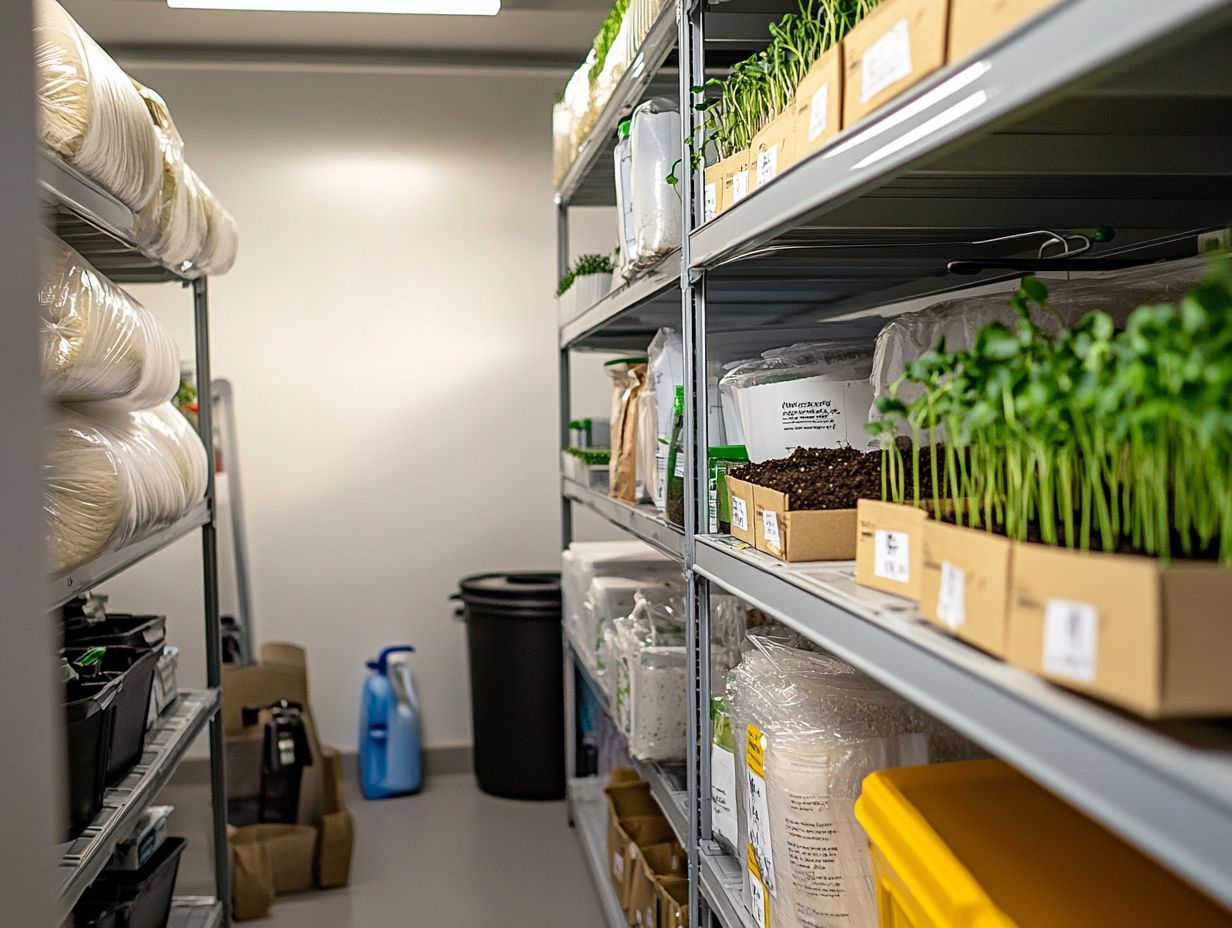
You will need airtight containers, paper towels, plastic bags, and a refrigerator to store your microgreen supplies.
How should I clean and prepare my storage containers?
Make sure to thoroughly clean and dry your containers before using them to store microgreens. You can also use food-safe sanitizers for added precaution.
Can I reuse containers to store microgreens?
Yes, you can reuse containers. Just make sure to clean them thoroughly between uses.
Use new containers every 2-3 cycles to keep things clean.
How should I store microgreen seeds?
Store microgreen seeds in a cool, dry place. Keep them away from direct sunlight.
Airtight containers or plastic bags in the refrigerator are great for long-term storage.
How often should I check on my stored microgreen supplies?
Check your stored supplies at least once a week. This helps ensure they stay fresh and prevents mold or bacteria growth.
How long can I store microgreen supplies in the refrigerator?
With proper storage, microgreen supplies last up to 7-10 days in the refrigerator. Regularly check for freshness and toss out any spoiled items.

